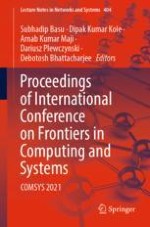2023 | Buch
Proceedings of International Conference on Frontiers in Computing and Systems
COMSYS 2021
herausgegeben von: Prof. Subhadip Basu, Prof. Dipak Kumar Kole, Dr. Arnab Kumar Maji, Prof. Dariusz Plewczynski, Prof. Debotosh Bhattacharjee
Verlag: Springer Nature Singapore
Buchreihe : Lecture Notes in Networks and Systems
